Traction Properties of Aerospace Lubricant under Low-Temperature Micro-Oil Droplet Supply Conditions
Abstract
:1. Introduction
2. Experimental Details
2.1. Traction Characteristic Tester
2.2. Lubricant Properties
2.3. Experimental Conditions
3. Results and Discussion
3.1. Slip–Roll Ratio
3.2. Load
3.3. Entrainment Velocity
3.4. Inlet Oil Temperature
4. Rheological Model Analysis
4.1. The H–B Model
4.2. The Modified H–B Model
4.3. The Modified H–B Model vs. the T–J Model
5. Conclusions
- (1)
- The kinematic viscosity of the lubricating oil increases significantly as the temperature decreases, while the white granular flocculence becomes higher in a microscopic state, reducing the fluidity.
- (2)
- The lubricant traction coefficient decreases as the load increases at low temperatures, and decreases at a higher entrainment velocity and lower inlet oil temperature.
- (3)
- The proposed modified H–B model for correction is consistent with the experimental data. The modified H–B model is compared with the commonly used lubricant rheological T–J model, yielding better fitting results. It is suitable for the engineering traction coefficient calculation of lubricating oil with low temperatures and high viscosities.
Author Contributions
Funding
Data Availability Statement
Conflicts of Interest
References
- Wu, H.H. Analysis of lubrication failure. In Proceedings of the Metallurgical Equipment Branch of China Metal Society and 2012 National Metallurgical Equipment Hydraulic Lubrication Pneumatic Technology Conference, Beijing, China, 12 June 2012. [Google Scholar]
- Wang, Y.S.; Liu, Y.L.; Zhang, G.L. Research review on the lubrication characteristics of space bearings. J. Tianjin Univ. Technol. Educ. 2018, 28, 1–5+85. [Google Scholar] [CrossRef]
- Pandey, K.R.; Ghosh, K.M. A thermal analysis of traction in elastohydrodynamic rolling/sliding line contacts. Wear Int. J. Sci. Technol. Frict. Lubr. Wear 1998, 216, 103–114. [Google Scholar] [CrossRef]
- Li, Z.; Lu, Y.F.; Zhang, C.; Dong, J.L.; Zhao, X.L.; Wang, L.Q. Traction behaviours of aviation lubricating oil and the effects on the dynamic and thermal characteristics of high-speed ball bearings. Ind. Lubr. Tribol. 2020, 72, 15–23. [Google Scholar] [CrossRef]
- Su, B.; Lu, X.T.; Su, Z.H.; Yang, H.S. Research on traction characteristics of a type of grease for lower-middle speeds bearing and its rheological models. Lubr. Eng. 2018, 43, 36–40+93. [Google Scholar] [CrossRef]
- Zhang, G.T.; Su, B.; Liu, P.; Wang, J.; Zhang, W.H. Experimental research on frictional torque of solid lubricated bearings in liquid nitrogen environment. Bearing 2023, 1–7. Available online: http://kns.cnki.net/kcms/detail/41.1148.TH.20230221.1110.004.html (accessed on 1 December 2023).
- Pasdari, M.; Gentle, C.R. Effect of lubricant starvation on the minimum load condition in a thrust-loaded ball bearing. A S L E Trans. 1987, 30, 355–359. [Google Scholar] [CrossRef]
- Gentle, C.R.; Pasdari, M. Computer simulation of starvation in thrust-loaded ball-bearings. Wear 1983, 92, 125–134. [Google Scholar] [CrossRef]
- Liu, S.Z.; Fu, H.R. The influence of low temperature on lubricating oil’s performance. Lubr. Oil 2010, 25, 18–20. [Google Scholar] [CrossRef]
- Wang, Y.S.; Cheng, J.W. Experimental analysis of viscosity temperature and rheological properties of aerospace bearing lubricating oil. Bearing 2015, 11, 39–41+63. [Google Scholar] [CrossRef]
- Wang, Y.S.; Cheng, J.W.; Li, H. Friction characteristics of space lubricating oil No.4129 in rolling and sliding contact. China Pet. Process. Petrochem. Technol. 2014, 16, 79–83. [Google Scholar] [CrossRef]
- Wang, Y.S.; Li, G.; Cheng, J.W. Impact factors to friction characteristics of space lubricating oil No.4116. J. Aerosp. Power 2016, 31, 2181–2187. [Google Scholar] [CrossRef]
- Zhang, L.Y.; Wang, Y.S.; Cao, J.W. Study on viscosity-temperature characteristic of lubricating oils used in high and low temperature instrument bearings. Bearing 2013, 10, 8–11. [Google Scholar] [CrossRef]
- Li, J.B.; Liu, J.Y.; Li, K.; Zhou, N.N.; Liu, Y.; Hu, X.D.; Yin, S.L.; Wang, G.R. Tribological properties of oil-impregnated polyimide in double-contact friction under micro-oil lubrication conditions. Friction 2023, 11, 1493–1504. [Google Scholar] [CrossRef]
- Shen, X.J.; Tao, D.H.; Gu, J.M. Study on the lubricant with advanced high-low temperature performance for instrument bearings. Lubr. Eng. 2010, 35, 92–95. [Google Scholar]
- Shen, Z.Q.; Liu, H.B.; Hao, J.H.; Yang, M.K.; Qiu, M. Finite element analysis of oil injection lubrication for high-speed rolling bearings. Bearing 2021, 10, 24–29. [Google Scholar] [CrossRef]
- Liang, H.; Zhang, Y.; Wang, W.Z. Influence of the cage on the migration and distribution of lubricating oil inside a ball bearing. Friction 2022, 10, 1035–1045. [Google Scholar] [CrossRef]
- Gao, S.; Han, Q.K.; Chu, F.L. Analysis of dynamic characteristics and skidding state of angular contact bearing by thermos-hydro-elasto-dynamic coupling model. J. Mech. Eng. 2022, 58, 87–97. [Google Scholar]
- Zhang, G.Y.; Liang, M.T.; Zhao, Y.Y.; Zhao, W.G.; Li, X.K. Theoretical and experimental study on the lubrication model and transient start-up process of the cryogenic rolling bearing. J. Mech. Eng. 2022, 58, 162–171. [Google Scholar]
- Qian, S.; Guo, D.; Liu, S.H.; Lu, X.C. Experimental investigation of lubricant flow properties under micro oil supply condition. J. Tribol. 2012, 134, 041501. [Google Scholar] [CrossRef]
- Karthikeyan, B.K.; Teodorescu, M.; Rahnejat, H.; Rothberg, S.J. Thermoelastohydrodynamics of grease-lubricated concentrated point contacts. Proc. Inst. Mech. Eng. Part C J. Mech. Eng. Sci. 2010, 224, 683–695. [Google Scholar] [CrossRef]
- Li, S.Y.; Guo, F.; Li, X.M. Numerical analysis of elastohydrodynamic lubrication behavior under micro oil droplet supply. Tribology 2016, 36, 413–420. [Google Scholar] [CrossRef]
- Li, X.M.; Guo, F.; Wang, S.P.; Liu, C.L.; Wang, W.Z. Behaviors of a micro oil droplet in an EHL contact. Friction 2016, 4, 359–368. [Google Scholar] [CrossRef]
- Li, Z.H.; Su, B.; Liu, P.; Li, J.T.; Wang, J.; Wei, B.Y. Development of traction performance testing machine for aerospace bearing lubricant. Lubr. Eng. 2022, 47, 114–119. [Google Scholar] [CrossRef]
- Liu, F.B.; Su, B.; Zhang, G.T.; Ren, J.L.; Zhang, W.H. Development of a Cryogenic Tester with Air Bearing to Test Sliding-Rolling Contact Friction. Lubricants 2022, 10, 119. [Google Scholar] [CrossRef]
- Wang, Y.S.; Cao, J.W.; Li, H. Study of frictional and viscosity-temperature characteristics of a space lubricating oil No.4129 in rolling/sliding contact. Acta Armamentarii 2014, 35, 1515–1520. [Google Scholar] [CrossRef]
- Wen, S.Z.; Huang, P.; Tian, Y.; Ma, L.R. Principles of Tribology, 5th ed.; Tsinghua University Press: Beijing China, 2020; pp. 5–37. [Google Scholar]
- Deng, S.E.; Teng, H.F.; Zhou, Y.W.; Wang, Y.S.; Yang, B.Y. Determination of constitutive equation of aviation lubricating oil HKD and computation on traction force. Lubr. Eng. 2006, 31, 24–27. [Google Scholar]
- Gohar, R.; Rahnejat, H. Fundamentals of Tribology, 3rd ed.; World Scientific Press: Singapore, 2018. [Google Scholar]
- Wang, W.Z.; Cao, H.; Hu, J.B. Numerical simulation of transient elastohydrodynamic lubrication of helical gears. Tribology 2011, 31, 604–609. [Google Scholar] [CrossRef]
- Wang, Y.S.; Cao, J.W.; Cai, Y.J. Study on low-temperature traction behavior of a space lubricating oil No.4116. China Pet. Process. Petrochem. Technol. 2015, 17, 111–116. [Google Scholar]
- Yoo, J.; Kim, K. Numerical analysis of grease thermal elastohydrodynamic lubrication problems using the Herschel-Bulkley model. Tribol. Int. 1997, 30, 401–408. [Google Scholar] [CrossRef]
- Tevaarwerk, J.L.; Johnson, K.L. The influence of fluid rheology on the performance of traction drives. J. Lubr. Technol. 1979, 101, 266–273. [Google Scholar] [CrossRef]
- Meng, Q.Z.; Yang, B.Y. The analysis of traction behavior of the new type high-speedaerial lubricating oil by the T-J model. Mach. Des. Manuf. 2006, 44, 9–11. [Google Scholar]

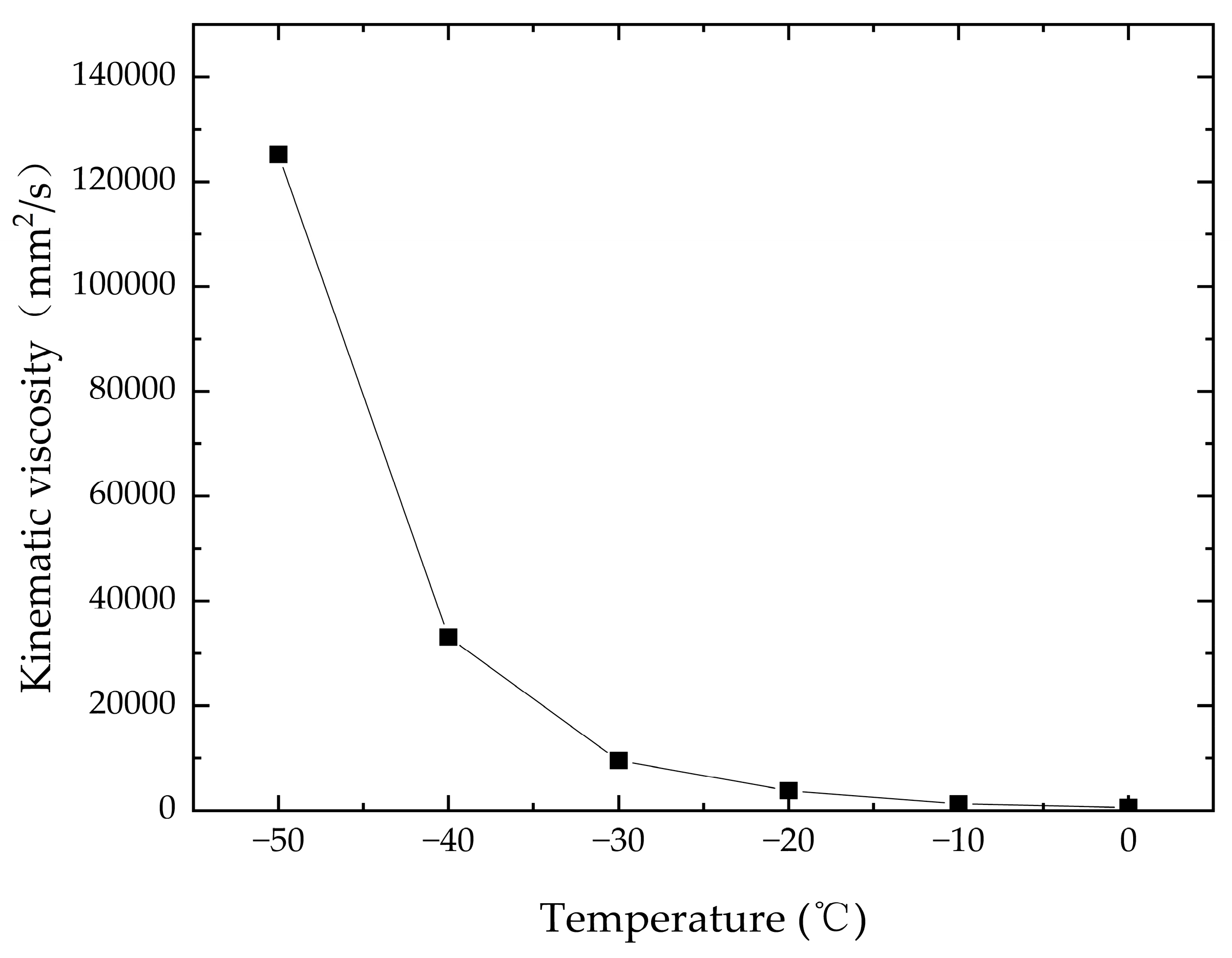



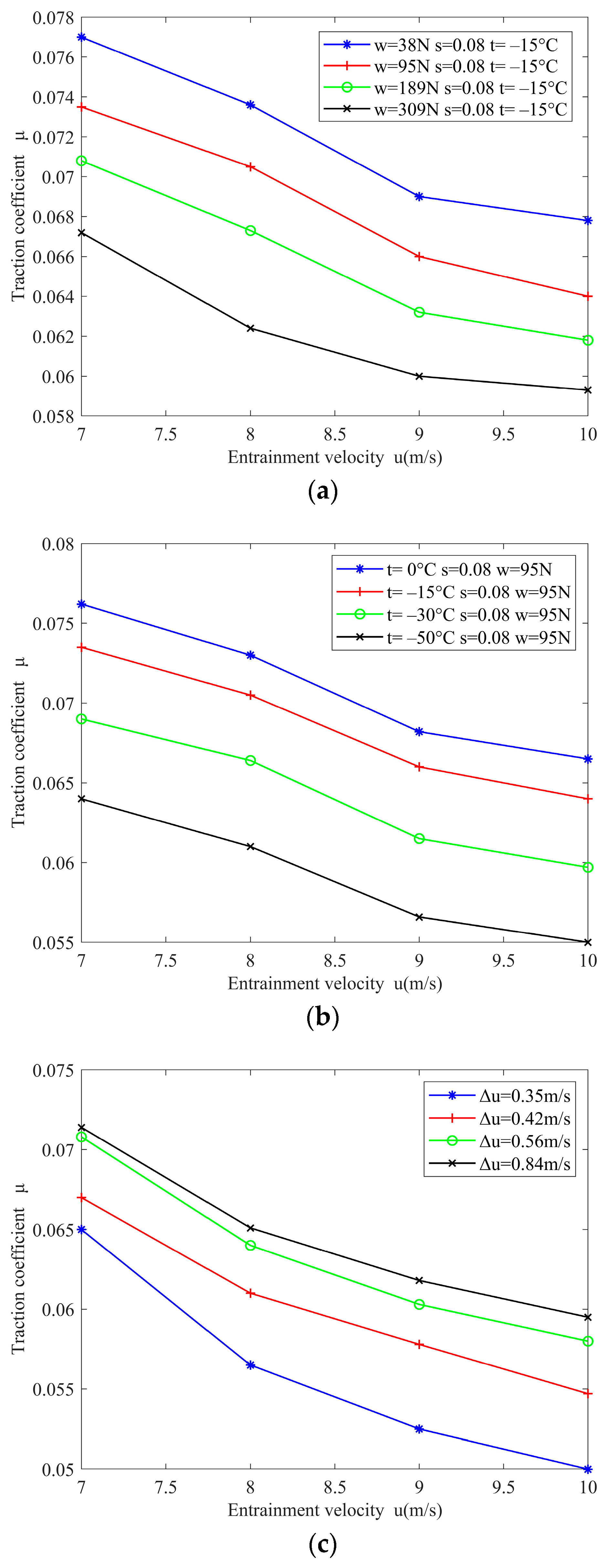

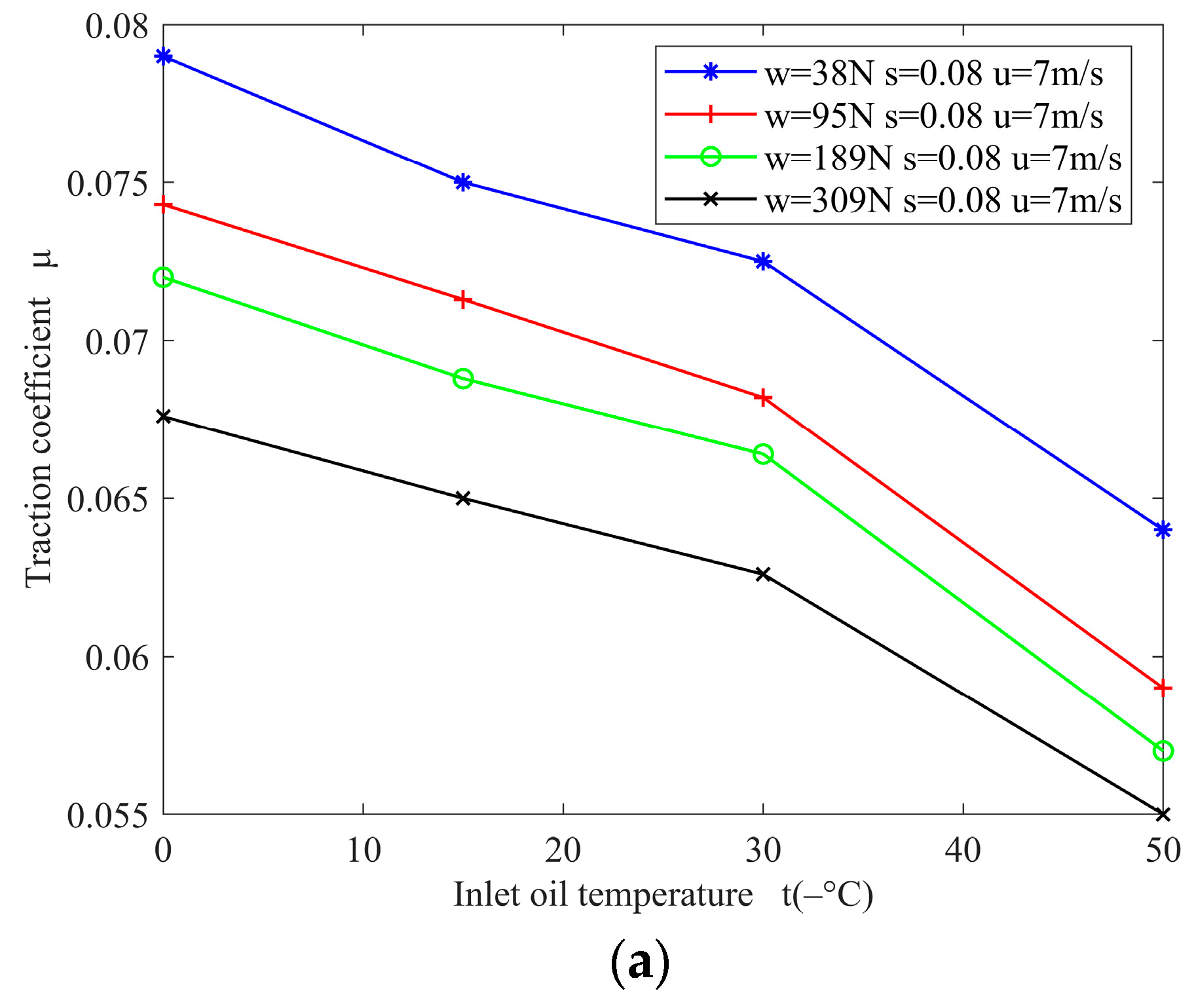
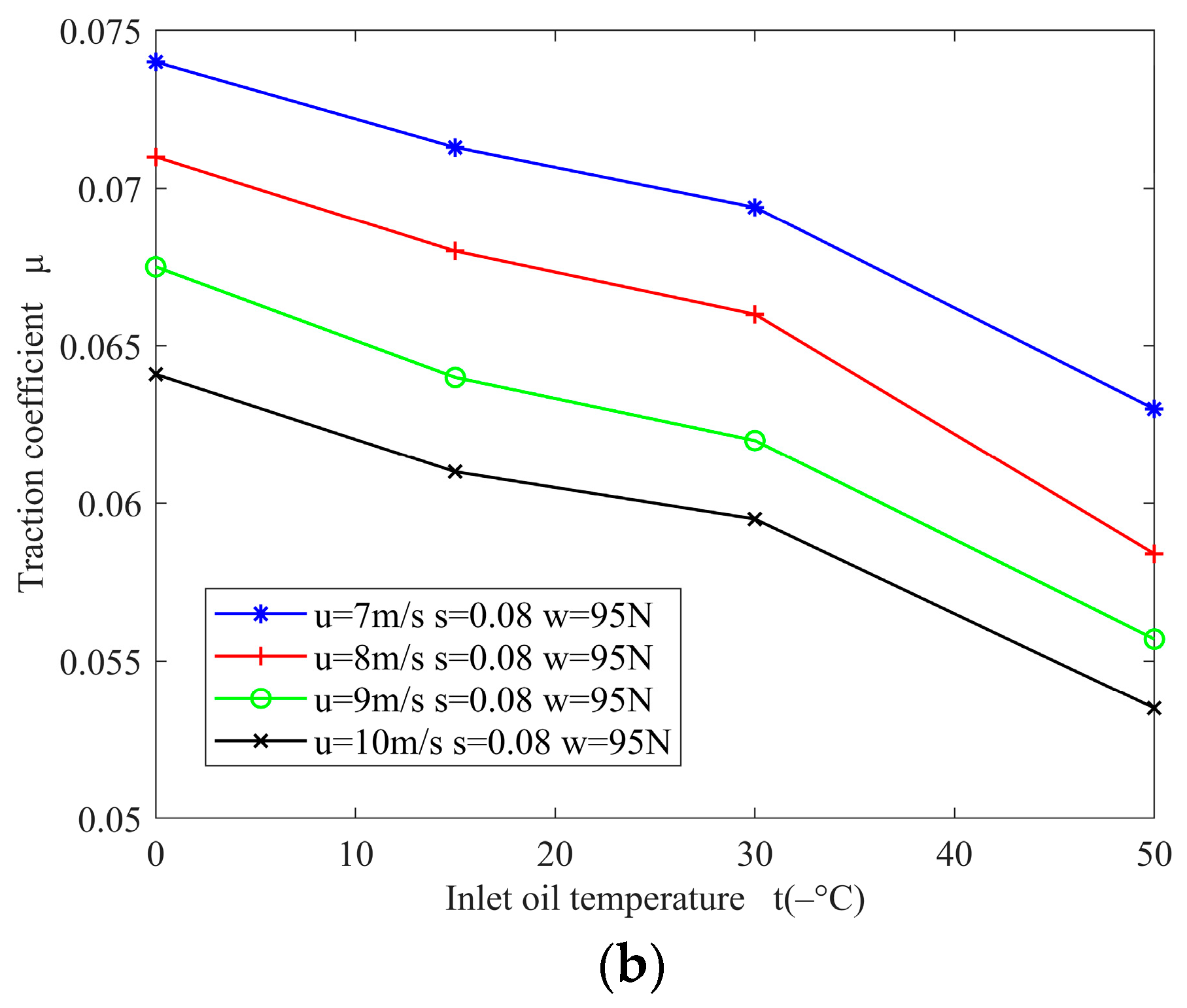
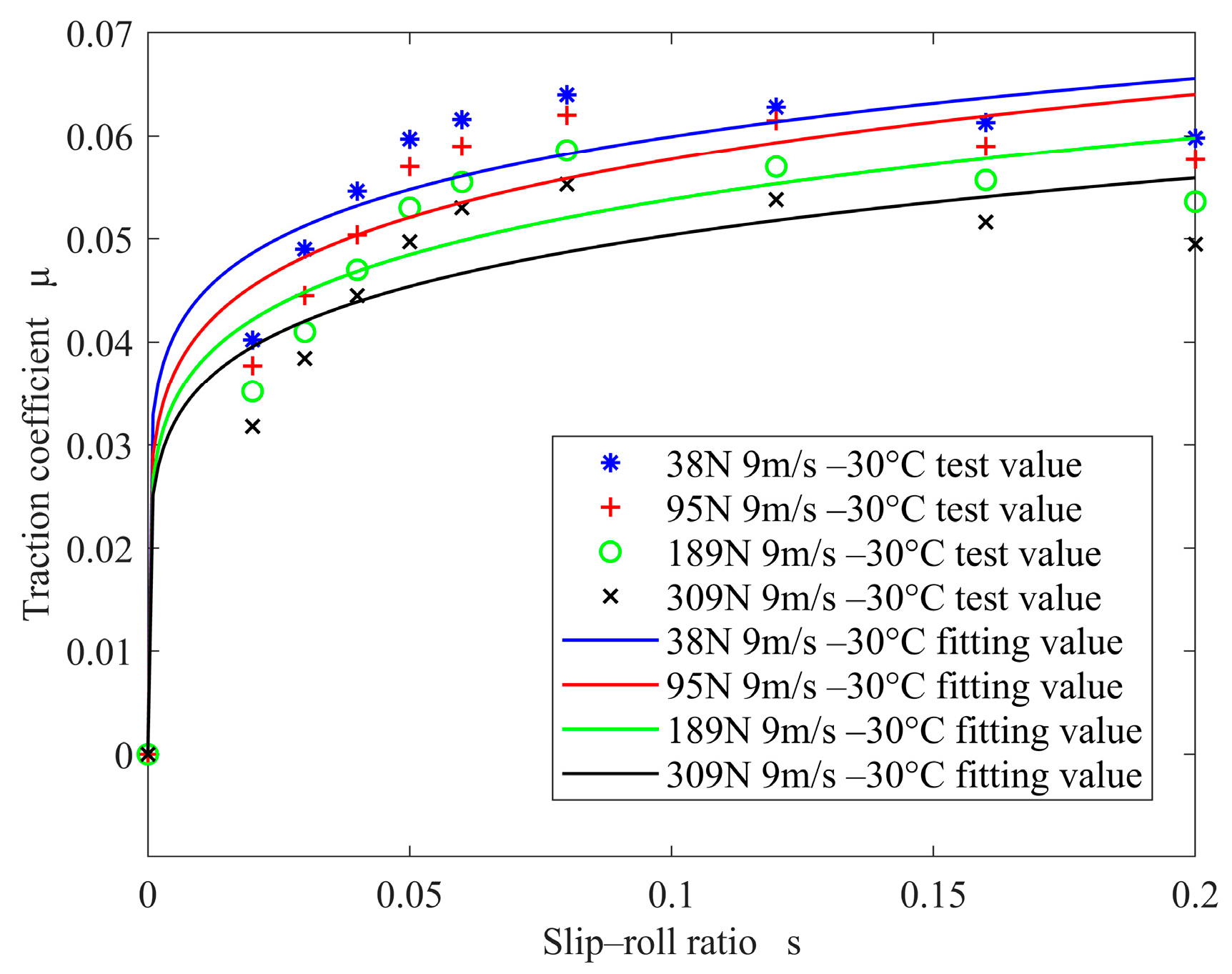


| Technical Parameters | Value |
|---|---|
| Viscosity index | 136 |
| Flashpoint, °C | 266 |
| Condensation point, °C | −57 |
| Neutralization value, mgKOH/g | 0.18 |
| Thermal conductivity K, N/(s · °C) | 1.5 |
Disclaimer/Publisher’s Note: The statements, opinions and data contained in all publications are solely those of the individual author(s) and contributor(s) and not of MDPI and/or the editor(s). MDPI and/or the editor(s) disclaim responsibility for any injury to people or property resulting from any ideas, methods, instructions or products referred to in the content. |
© 2023 by the authors. Licensee MDPI, Basel, Switzerland. This article is an open access article distributed under the terms and conditions of the Creative Commons Attribution (CC BY) license (https://creativecommons.org/licenses/by/4.0/).
Share and Cite
Gao, F.; Tian, L.; Cui, Y.; Zhao, Y.; Su, B.; Sun, L. Traction Properties of Aerospace Lubricant under Low-Temperature Micro-Oil Droplet Supply Conditions. Lubricants 2023, 11, 528. https://doi.org/10.3390/lubricants11120528
Gao F, Tian L, Cui Y, Zhao Y, Su B, Sun L. Traction Properties of Aerospace Lubricant under Low-Temperature Micro-Oil Droplet Supply Conditions. Lubricants. 2023; 11(12):528. https://doi.org/10.3390/lubricants11120528
Chicago/Turabian StyleGao, Fei, Ling Tian, Yongcun Cui, Yan Zhao, Bing Su, and Liming Sun. 2023. "Traction Properties of Aerospace Lubricant under Low-Temperature Micro-Oil Droplet Supply Conditions" Lubricants 11, no. 12: 528. https://doi.org/10.3390/lubricants11120528
APA StyleGao, F., Tian, L., Cui, Y., Zhao, Y., Su, B., & Sun, L. (2023). Traction Properties of Aerospace Lubricant under Low-Temperature Micro-Oil Droplet Supply Conditions. Lubricants, 11(12), 528. https://doi.org/10.3390/lubricants11120528





